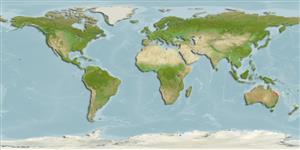分類 / Names
共通名の | 類義語 | Catalog of Fishes(部類, 種) | ITIS | CoL | WoRMS | Cloffa
>
Eupercaria/misc (Various families in series Eupercaria) >
Sparidae (Porgies)
Etymology: Acanthopagrus: Greek, akantha = thorn + Greek, pagros, a kind of fish (Ref. 45335).
More on author: Günther.
Environment: milieu / climate zone / depth range / distribution range
生態学
海; 汽水性の 底生の; 海洋回遊性. Temperate; 19°S - 38°S
Southwest Pacific: endemic to eastern Australia, from Townsville in Queensland to the Gippsland Lakes in Victoria (Ref. 75154). Occurrence in Japan and Ryukyu Islands (Ref. 559) and Taiwan (Ref. 5193) need verification.
Length at first maturity / サイズ / 重さ / 年齢
Maturity: Lm ?, range 24 - ? cm
Max length : 66.0 cm SL オス/雌雄の選別がない; (Ref. 44894); 最大公表体重: 4.5 kg (Ref. 6390); 最大記録サイズ: 14 年 (Ref. 56606)
Inhabitant estuaries, coastal rivers, creeks, lakes and bays, usually in marine or brackish water, but in dry seasons they penetrate the lowermost reaches of fresh water (Ref. 44894). Common in coastal and estuarine rocky habitat. They enter rivers upstream to the limit of brackish waters. They migrate from their feeding to their spawning grounds; they spawn mainly during winter in the vicinity of river entrances; eggs are planktonic and hatch after 2.5 days. A portion of the population changes sex from male to female after spawning. They feed on mollusks, crustaceans, worms, fish and ascidians. It is parasitised by the monogeneans Anoplodiscus australis and A. spari on the fins and body surface (Ref. 124057).
Life cycle and mating behavior
成熟 | 繁殖 | 放精 | 卵 | 生産力 | 幼生
A proportion of the population change sex from male to female after their first spawning season (Ref. 6390). Other fish remain functional males throughout their life and another small proportion develop directly into females at the age of 4 years (Ref. 27246, 28262). Also Ref. 28504.
The eggs and larvae are planktonic (Ref. 30572). After about four weeks the developed fry enter the estuary at night on the full moon and settle in estuarine littoral areas at about 1.4 cm in length (Ref. 30572). The fry rapidly develop into juveniles and grow to about 10 cm after one year (Ref. 30572).
Kailola, P.J., M.J. Williams, P.C. Stewart, R.E. Reichelt, A. McNee and C. Grieve, 1993. Australian fisheries resources. Bureau of Resource Sciences, Canberra, Australia. 422 p. (Ref. 6390)
IUCNのレッドリストの状況は (Ref. 130435: Version 2024-1)
Human uses
水産業: 商業; 水産養殖: 商業; ゲームフィッシュ: はい
用具
特記事項
XMLをダウンロードして下さい
インターネットの情報源
Estimates based on models
Preferred temperature (Ref.
123201): 20.2 - 26.1, mean 24.7 °C (based on 68 cells).
Phylogenetic diversity index (Ref.
82804): PD
50 = 0.5000 [Uniqueness, from 0.5 = low to 2.0 = high].
Bayesian length-weight: a=0.01259 (0.00609 - 0.02604), b=3.03 (2.86 - 3.20), in cm total length, based on LWR estimates for this (Sub)family-body shape (Ref.
93245).
栄養段階 (Ref.
69278): 3.1 ±0.40 se; based on food items.
回復力 (Ref.
120179): 低い, 4.5年~14年の倍増期間の最小個体群 (tm=3-4; tmax=14; Fec=300,000).
Fishing Vulnerability (Ref.
59153): Moderate to high vulnerability (52 of 100).
Nutrients (Ref.
124155): Calcium = 35.9 [17.6, 68.9] mg/100g; Iron = 0.358 [0.201, 0.691] mg/100g; Protein = 19.4 [18.3, 20.5] %; Omega3 = 0.57 [0.34, 0.97] g/100g; Selenium = 10.5 [5.1, 20.6] μg/100g; VitaminA = 10.2 [3.0, 30.3] μg/100g; Zinc = 0.67 [0.47, 0.95] mg/100g (wet weight);
